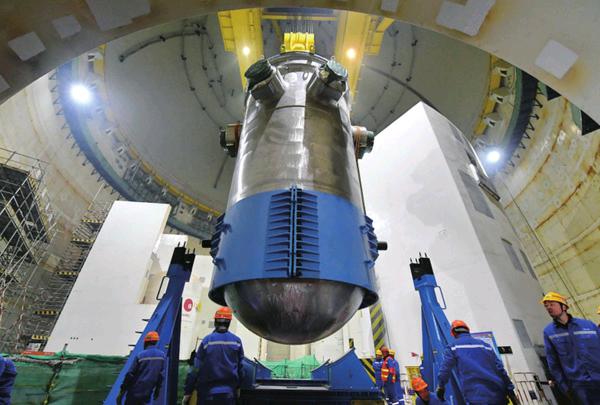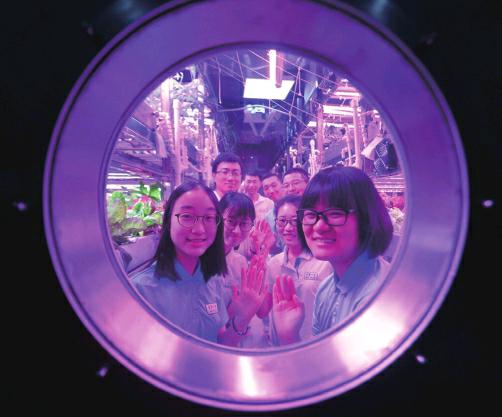Sea of Ice
2018-02-23
Fishing boats are locked together by the frozen sea in the waters surrounding Xingcheng, northeast Chinas Liaoning Province, on January 28.
Deep Sea Exploration
On January 30, Chinese research vessel Ocean No.6 fi nished a 219-day, deep-sea scientifi c exploration in the western Pacifi c Ocean, returning to Dongguan, south Chinas Guangdong Province.
He Gaowen, chief scientist onboard the ship, described how the researchers sailed nearly 53,000 km, using a comprehensive geological and geophysical survey method to collect geological samples from 269 survey stations and environmental samples from a further 111 survey stations.
The researchers obtained 10,143 km of geophysical line data from four research areas within a 200,000-square-km area of the western Pacifi c Ocean, which has helped to lay the foundation for future resource evaluation, He said. Wang Yan, Deputy Director of the China Geological Survey Bureau, said the research undertaken by Ocean No.6 has accumulated valuable experience in conducting comprehensive geological, geophysical, and environmental survey operations in the deep ocean.
Community Services
China will improve community health services for people living with severe mental illness, who currently number 5.81 million, according to offi cial records.
An inter-ministry conference has been held to address the issue.
Wang Bin, an offi cial at the National Health and Family Planning Commission, said that according to the latest surveys, China had only 31,000 licensed psychiatrists and 2,900 mental health institutions.
This imbalance has prompted the creation of policies to help mental health patients receive care in the home. Last year, a government circular demanded that community health services be provided for mental health patients in most cities and counties by 2025.
According to the circular, by then 60 percent of patients will be able remain at home and receive care from community health workers.
“China has a large number of mental health patients, many of whom cannot work and are mired in poverty,” said Gao Xiaobing, Vice Minister of Civil Affairs, who attended the conference.
“It is important to help them recover the ability to live indepen- dently and reacquire social skills through community services,” she said.
Gao asked local governments to increase spending in order to improve community services for mental health patients and fi nd ways to help them not just recover but return to work and a normal life.endprint
Gambling Crackdown
Chinese police will crack down on gambling, targeting operators and the protective “umbrellas” behind the illegal activity, the Ministry of Public Security said on January 29.
Huang Ming, Vice Minister of Public Security, said that gambling harmed the social atmosphere, cultivated crime and posed a direct threat to the security of peoples property and social stability, at a national video conference on tackling illegal gambling.
Chinese police have investigated 5.93 million suspects in 1.74 million gambling cases since the 18th National Congress of the Communist Party of China in 2012.
However, the country is now facing a different challenge in the fi ght, with rural areas now posing a serious gambling problem, the ministry said.
Huang ordered police departments nationwide to focus on companies running illegal gambling businesses, “underground banks”and online operators involved in illicit activities.
“Those who are found to have engaged in gambling and obstructed the investigation of crimes will be severely punished,” Huang said.
General Practitioners
China needs 500,000 more general practitioners by 2030, a health offi cial said on January 25.
At present, China has 209,000 general practitioners, but the new plan aims to allow every 10,000 residents to access f vie competent general practitioners in the next 12 years, said Zeng Yixin, deputy head of the National Health and Family Planning Commission, at a press conference.
Citing a guideline on the development of general practitioners issued by the State Council, Zeng said that key reforms would be carried out, including the increase of salaries and the social status of general practitioners in efforts to make it a more attractive prospective career.
“As general practitioners usually offer services in local communities, villages and towns, they are more familiar with the lifestyles and health conditions of the local people than the doctors at larger hospitals in nearby cities,” Zeng said. “Therefore, general practitioners play a crucial role in local disease prevention and health care, easing the workload of larger public hospitals.”
According to the guideline, China plans to have two or three competent general practitioners per 10,000 residents by 2020.
While medical schools are to open more programs to train general practitioners, teaching hospitals are being encouraged to open general practice departments.endprint
The report of the 19th National Congress of the Communist Party of China stressed improving community level healthcare services, and strengthening the ranks of general practitioners.
In 2015, there were 189,000 general practitioners in China, accounting for only 6.2 percent of all doctors, with one general practitioner for every 10,000 citizens, according to the commission.
Going Off Road
Beijing authorities have devised a new method for keeping cars off the road by using fi nancial rewards to ease traffi c jams and control emissions.
On January 30, China Beijing Environment Exchange launched a program which gives money to motorists who choose not to drive.
According to the exchange, drivers must register on the programs public WeChat account to receive a device that monitors their vehicles motion, in exchange for a deposit of 998 yuan ($158), although the device is free if the driver buys insurance from the exchanges partner company.
The driver then receives 0.5 yuan ($0.08) for each day the vehicle is not driven, with up to 20 yuan ($3.18) also on offer from the exchanges partner companies.
The China Beijing Environment Exchange was established in 2008 under the approval of the Beijing government with the aims of reducing emissions and saving energy.
According to the Traffi c Management Bureau of the Ministry of Public Security, Beijing has more than 3 million cars.
Weaving Fun
Tourists visit a Tujia tapestry weaving center in the Wulingyuan District of Zhangjiajie, central Chinas Hunan Province, on January 30. The tapestry weaving of the Tujia ethnic group has been listed as an intangible cultural heritage.
HIV Testing Stations
Southwest Chinas Yunnan Province has built stations to quickly test for HIV across its rural area, as part of the latest efforts to control HIV/AIDS, provincial health authorities said.
More than 2,700 stations have been built in 800 villages, or 99 percent of townships in the province, said Jia Manhong, an offi cial of the provincial center for disease prevention and control (CDC).
More than 15 million people received HIV tests in the province last year, and more than 90 percent of them received treatment for the virus, according to the provincial CDC.
Lu Lin, deputy head of the provincial health and family planning commission, said the stations help patients receive treatment as quickly as possible.endprint
Intravenous drug use was once the major cause of HIV infection in Yunnan, given its position on the border of the notorious Golden Triangle in Southeast Asia.
However, those considered at a high risk of infection has expanded from drug users to ordinary people, with unprotected sex the principal means of transmission accounting for 94 percent of new infections last year.
Festive Cooking
A pastry chef makes steamed Linzi rice cakes at a bakery in Rugao, east Chinas Jiangsu Province, on January 30. As Chinas Spring Festival approaches, more festive snacks are beginning to appear in local markets nationwide.
Restructuring Nuclear Power Firms
The State Council has approved the restructuring of two leading Chinese nuclear power companies, China National Nuclear Corp.(CNNC) and China Nuclear Engineering and Construction Group Corp. Ltd. (CNEC), according to an offi cial announcement on January 31.
CNEC will be taken over by CNNC, according to the announcement by the State-Owned Assets Supervision and Administration Commission of the State Council. The move will reduce the number of major state-owned enterprises under direct supervision of the administration to 97.
CNNC is a major player in terms of investment, operation and development in Chinas nuclear power sector.
Strategic restructuring of Chinas state-owned enterprises in equipment making, coal, power, communication, and chemical engineering sectors will accelerate this year, according to experts.
Nuclear Power Unleased
A reactor pressure vessel is installed at the China National Nuclear Corp.s Fuqing Nuclear Power Plant in Fujian Province on January 28. It is Chinas fi rst nuclear power project to use Hualong One technology, a domestically developed third-generation reactor design.
Optimistic U.S. Companies
Confi dence within the U.S. business community toward Chinas economy is strengthening, despite concerns about the regulatory environment, according to a survey released on January 30.
The survey, conducted by the American Chamber of Commerce in China (AmCham-China) in partnership with Bain & Company, also showed increasing optimism in China-U.S. relations despite the possibility of the Trump administrations action against Chinese trade and investment practices.
Some 36 percent of respondents believe relations between the two countries will improve this year, compared with 17 percent last year.endprint
“Regarding the economy, there is cautious optimism that the new normal rate of growth is sustainable for the foreseeable future, providing opportunities for business to expand,” said William Zarit, Chairman of AmCham-China.
Some 64 percent of member companies reported revenue growth in 2017, up from 58 percent in 2016 and 55 percent in 2015.
Nearly six in 10 companies rank China among their top three investment priorities, up from the previous year but still below the historical average.
The survey also found one third of members plan to expand their investment in China by more than 10 percent in 2018, and 67 percent of consumer companies see China as either leading in digital technology for their fi eld or more advanced than other markets.
Nevertheless, regulation remains a concern for many. Respondents cited inconsistent regulatory interpretation and unclear laws and enforcement as the top challenges to doing business in China.
The survey was conducted between October 23 and November 26, 2017, and was sent to 849 member company representatives, of whom 411 completed a signifi -cant portion.
Chinas economy expanded 6.9 percent in 2017, with the pace of growth accelerating for the fi rst time in seven years.
Cultural Industry
Chinas cultural industry accelerated its expansion last year, helped by the rapid growth of information transmission services, offi cial data showed on January 31.
The sectors combined revenue rose 10.8 percent to 9.2 trillion yuan ($1.5 trillion) in 2017, the National Bureau of Statistics (NBS) said in a statement.
The growth rate was higher than the 7.5 percent achieved in 2016 and 6.9 percent in 2015.
The NBS tracked some 55,000 companies across 10 cultural sectors—six that offer cultural services and four involved in the manufacture of cultural products.
Revenue from information transmission services increased the most, by 34.6 percent year on year, followed by cultural and artistic services, and recreation and entertainment services.
Manufacturing of cultural products, which accounted for more than one third of the sectors total revenue, posted an 11.4-percent growth in revenue.
The countrys eastern regions contributed 74.7 percent to the overall cultural revenue in 2017, according to the NBS.
Information Services
The boom of Chinas information services continues, as the sector saw a 76.4-percent annual growth in 2017, the Ministry of Industry and Information Technology (MIIT) said on January 30.endprint
Mobile Internet and data usage increased 26.7 percent in 2017, with the monthly average for data consumed per household reaching 1,775 megabytes, more than double that in 2016, said MIIT Chief Engineer Zhang Feng.
Chinas 4G network users in 2017 totaled almost 1 billion, accounting for 70 percent of mobile phone users in the country, above the average for developed countries, according to MIIT data.
The fi xed-line broadband network covered 72.5 percent of users by the end of 2017, and over 125 major data centers had been built. In addition, there were breakthroughs in cloud computing, according to the ministry.
The revenue growth rate of Chinas listed Internet companies topped 40 percent for the sixth consecutive year, and their total revenue is expected to reach 1.4 trillion yuan ($221 billion) for 2017, Zhang said.
China has said it will target high quality growth, with the service sector and hi-tech industries gaining strength.
Offi cial data showed that newenergy vehicles, industrial robots, solar power and integrated circuits outshone most other industries in terms of output in 2017, contributing to a pick-up in industrial output growth last year.
Canine Creations
An artisan paints a dog design on a plate in Handan, Hebei Province, on January 31, two weeks before the Chinese Lunar New Year, which falls on February 16 this year.
International Lender
China Development Bank (CDB), a major policy bank, reported a drop in bad loans last year.
CDB Governor Zheng Zhijie said the ratio of non-performing loans (NPLs) had remained below 1 percent for 51 consecutive quarters by the end of 2017, a level markedly lower than the 1.74 percent of commercial banks in the third quarter of last year.
The bank will continue to step up risk control to ensure stable asset quality, Zheng said.
Founded in 1994, CDB is designed to provide fi nance to major national projects and development strategies. It has become the worlds largest development fi nance institution and the largest Chinese bank for foreign investment, long-term lending and bond issuance.
CDB lent $17.6 billion to regions along the routes of the Silk Road Economic Belt and the 21st-Century Maritime Silk Road last year and made loan commitments worth 99.1 billion yuan ($15.65 billion). Outstanding loans to overseas businesses stood at $332.7 billion, the largest for Chinese lenders.
The bank has also channeled more energy into fi nancing urbanization projects, emerging sectors, environmental protection and other national priorities.
The total assets of CDB rose to 15.67 trillion yuan ($2.47 trillion) at the end of 2017, up from 14 trillion yuan ($2.21 trillion) in the previous year.
Cabin Fever
Volunteers wave from inside a cabin at Beihang University in Beijing on January 26. Four students spent 200 days in the simulated space lab, setting a record for the longest stay in a self-contained cabin.
The biomedicine students from Beihang University, the second group of volunteers to stay in Yuegong-1, completed the second phase of a 365-day on-ground experiment that day. endprint
endprint
